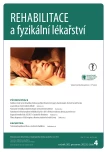Comparison of methodologies in degenerative changes of the cervical spine
Authors:
Musilová E. 1; Olaszová Vavro D. 2
Authors‘ workplace:
Fakulta telesnej výchovy a športu, Univerzita Komenského v Bratislave, Slovenská republika
1; Fyziotherapy s. r. o., Bratislava, Slovenská republika
2
Published in:
Rehabil. fyz. Lék., 30, 2023, No. 4, pp. 183-188.
Category:
Original Papers
doi:
https://doi.org/10.48095/ccrhfl 2023183
Overview
The cervical spine is the most mobile part of the spine. It allows movements in all directions of a large range. Recently, the number of younger patients with degenerative changes in this region has been increasing. The accompanying sign is the presence of pain, limitation of the range of mobility, muscular imbalance. However, with targeted physiotherapy it is possible to influence the pain and functional changes. We investigated the possibilities of influencing the range of motion of the cervical spine by selected physiotherapeutic methods and to map the effectiveness of the selected methodologies. We conducted the study through a monthly clinical survey. The inclusion criteria for patients were sedentary occupation and cervical spine pain. The cohort consisted of 34 patients divided into three groups. At the beginning and end of the survey, we evaluated the Fleche-Forestier. Dynamic neuromuscular stabilization in the first group, postisometric and antigravity relaxation in the second group, and the McKenzie method in the third group. We found the most significant improvement in the third group in Fleche-Forestiere measurement, anteflexion and retroflexion. The differences in lateroflexion and rotation values were negligible. The treatment according to McKenzie appears to be an effective method in improving range and function of the cervical spine.
Keywords:
pain – vertebrogenic diseases – dynamic neuromuscular stabilization – postisometric and antigravity relaxation – McKenzie concept
Sources
1. Hatiarová K. Návrh skríningovej metódy na vyhľadávanie rizikových pracovníkov z hľadiska vzniku syndrómu karpálneho tunela. Verejne.zdravotnictvo.szu.sk. [online]. Dostupné z: http:/ / verejnezdravotnictvo.szu.sk/ SK/ 2007/ 2007-4/ hatiarova.htm.
2. Kačinetzová A, Juhaňáková M, Kolářová M et al. Rehabilitace. Sborník příspěvků. Praha: Triton 2010.
3. Ambler Z, Potužník P, Polívka J. Základy neurológie. Praha: Galén 2023.
4. Kolář P et al. Rehabililace v klinické praxi. Praha: Galén 2020.
5. Chrobok J. Náhrady bederních medziobratlových plotének endoprotézou Prodisc-L u degeneratívnich diskopatií. Brno, 2006. Dizertační práce. Masarykova univerzita, Lékařská fakulta. Vedoucí prof. MU Dr. Martin Krbec, CSc.
6. Lewit K. Manipulační léčba. Praha: Sdělovací technika 2003.
7. Adams MA, Roughley PJ. What is intervertebrale disc degeneration and what causes it? Spine 2006; 31(18): 2151–2161. [online]. doi: 10. 1097/ 01.brs.0000231761.73859.2c.
8. Kotrbancová M. Metóda McKenzieho – Kazuistika. Rehabilitácia 2016; 43(4): 218–221.
9. Sarno J. Uzdravení od bolesti zad. Propojení těla a mysli. Bratislava: Noxi 2019.
10. Gúth A. Liečebné metodiky v rehabilitácii. Bratislava: Liečreh Gúth 2022.
11. McKenzie R. Léčime si záda sami. McKenzie Institut Czech Republic 2014.
Labels
Physiotherapist, university degree Rehabilitation Sports medicineArticle was published in
Rehabilitation & Physical Medicine

2023 Issue 4
Most read in this issue
- Professional voice disorders and possibilities of treatment
- Validation of the Czech Movement Imagery Questionnaire-Revised Second Version in stroke survivors
- Comparison of methodologies in degenerative changes of the cervical spine
- Evaluation of the effect of complex rehabilitation care for children with cerebral palsy after the first year of operation of the new code OD 0035 in Sanatoria Klimkovice
